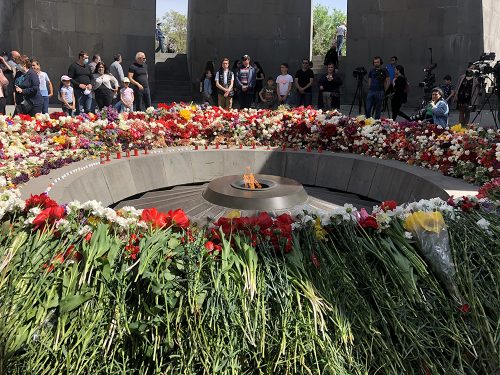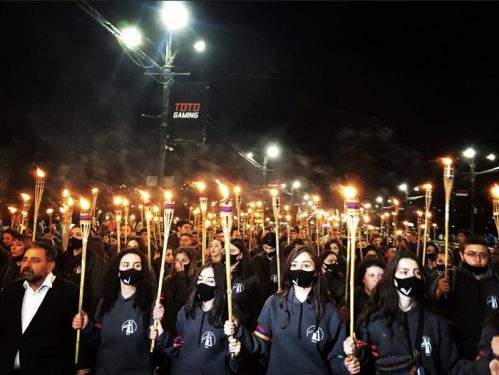
By Engy Magdy, Special to The Tablet
YEREVAN, Armenia — Armenia has a rich history. It begins with the story of Noah and Noah’s Ark, which was anchored over Mount Ararat. The surrounding lands make up Greater Armenia, which witnessed the slaughter of millions by the Ottomans and the demolition of churches by the Communists.
Despite its heavy losses, Armenia survived and rose up to commemorate the innocent souls who were massacred during the Armenian Genocide.
Every year, on April 24, Armenians honor as many as 1.5 million ethnic Armenians who were killed by Ottoman Turk soldiers between 1915 and 1923 during the breakup of the Ottoman Empire.
This year, on April 23, the Armenian people walked in a rally starting from the center of Yerevan to the Armenian Genocide Memorial Complex on the hill of Tsitsernakaberd.
Sorrow and silence overwhelmed the scene, with the light of candles symbolizing a constant cry and non-stop mourning for all those who had been killed 100 years ago. People appealed for international recognition of the 20th century’s first genocide.
In a statement released on Armenian Remembrance Day, President Joe Biden became the first U.S. president to officially refer to the deaths as a “genocide.”
“Each year on this day, we remember the lives of all those who died in the Ottoman-era Armenian genocide and recommit ourselves to preventing such an atrocity from ever again occurring,” the president wrote.
On the morning of April 24, thousands of Armenians again walked to the memorial, in a scene that looked like the exodus. They walked in silence and at a slow pace bearing flowers to lay for the victims at the circular memorial which featured a flame in the center in remembrance of the victims.
“Armenians were burnt alive inside their homes by Othman forces,” Harutyun Marutyan, director of the Armenian Genocide Museum-Institute told The Tablet.
During a meeting with Marutyun in his office at the Armenian Genocide Museum-Institute, he recounted some of the stories shared about the crimes committed by Ottomans against Armenians — the execution of 260 Armenian scholars, artists, and doctors on April 24, 1915, sending 120,000 Armenian soldiers to the front lines in the army, stripping them of their weapons and executing them, forcing many to convert to Islam, among others.
Turkey has acknowledged the deaths of the Armenian people but disputes whether they were intentional and says the numbers were much lower than a million.

“The problem is that the Turkish governments, [for] decades, deceived their people. The state insists to deny everything,” Marutyan said.
The hope is the Turkish government can acknowledge the genocide similar to how Germany recognized the Holocaust, which Marutyan explains was a decisive step to prevent more carnage against Jewish people.
In 1918, the Ottomans were defeated in the Battle of Sardarabad, and the Armenians ended their nightmare and regained part of their stolen lands. However, barely two years had passed until a new chapter of pain and persecution began under the Soviet era and the rule of communism. Armenia became part of the Soviet Union under the name of “Arminskaya.”
For more than 70 years, which ended with the fall of the Berlin Wall and the collapse of the Soviet Union in 1989, Armenian Christians and religious minorities lived under the brunt of communist persecution. This was manifested in the demolition of churches and the killing of four thousand people because of their faith. Soviet leader Joseph Stalin used to exile to Siberia any Russian Christians who dared to visit Armenia.
In the years of communism, religious persecution was the rule — two mosques and 10 churches were destroyed, some of which dated back to the fourth and fifth centuries.
In spite of decades of persecution, the Armenian people were strong enough to keep their land, culture, identity, and adherence to life surviving to this day.
However, there is still work to be done, and according to Matutyan, it’s a matter of life or death. He cites the killing of hundreds of Armenians by Azeri troops in Sangeet city 30 years ago and the wiping out of the Armenian monuments in Nagorno-Karabakh.
Last year, the people of the Nagorno-Karabakh region suffered killings and were displaced by the forces of Azerbaijan who had the full support of Turkey.
“It hasn’t ended yet. We feel the same danger today,” Matutyan said.
